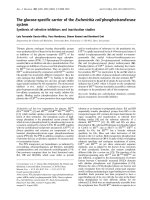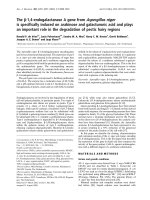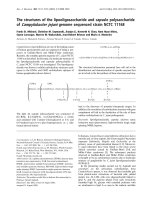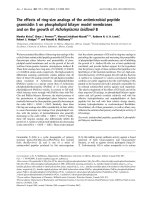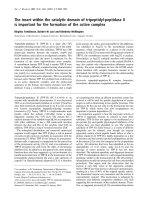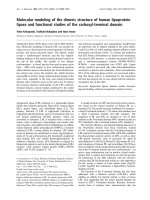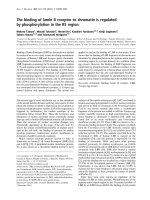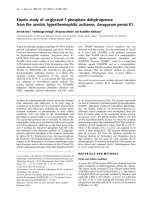Báo cáo Y học: The presence of phosphate at a catalytic site suppresses the formation of the MgADP-inhibited form of F1-ATPase potx
Bạn đang xem bản rút gọn của tài liệu. Xem và tải ngay bản đầy đủ của tài liệu tại đây (449.61 KB, 8 trang )
The presence of phosphate at a catalytic site suppresses
the formation of the MgADP-inhibited form of F
1
-ATPase
Noriyo Mitome, Sakurako Ono, Toshiharu Suzuki, Katsuya Shimabukuro, Eiro Muneyuki
and Masasuke Yoshida
Chemical Resources Laboratory, Tokyo Institute of Technology, Japan
F
1
-ATPase i s inactivated by entrapment of MgADP in
catalytic sites and reactivated by MgATP or P
i
. Here, using a
mutant a
3
b
3
c complex of thermophilic F
1
-ATPase
(aW463F/ bY341W) and monitoring nucleotide b inding by
¯uorescence q uenching of an introduced tryptophan, we
found that P
i
interfered with the binding of MgATP to
F
1
-ATPase, but binding of MgADP was interfered with to a
lesser e xtent. Hydrolysis of MgATP by F
1
-ATPase during
the experiments did not obscure the interpretation because
another mutant, which was able to bind nucleotide but not
hydrolyse ATP (aW463F/bE190Q/bY341W), a lso gave the
same results. The half-maximal concentrations of P
i
that
suppressed the MgADP-inhibited form a nd interfered with
MgATP binding were both 20 m
M
.Itislikelythatthe
presence of P
i
at a catalytic site shifts the equilibrium from
the MgADP-inhibited form to the enzyme±MgADP±P
i
complex, an active intermediate in the catalytic cycle.
Keywords: competition; F
o
F
1
-ATP synthase; MgADP
inhibition; nucleotide binding; tryptophan ¯uorescence.
F
o
F
1
-ATP synthase synthesizes ATP from ADP and
inorganic phosphate (P
i
) by using the energy of proton
¯ow driven by a transmembrane electrochemical proton
gradient [1±3]. The enzyme c onsists of a c ytoplasmic
domain, referred to as F
1
-ATPase or F
1
, which carries
catalytic sites for the synthesis and hydrolysis of ATP, and a
membrane integral domain, F
o
, which conducts protons
across the membrane. F
1
has a subunit composition a
3
b
3
cde
and can be reversibly separated from F
o
.Therearesix
nucleotide-binding sites in F
1
-ATPase, thre e of which are
catalytic sites, located on the b s ubunits, and three other
noncatalytic sites, located on the a subunits. In the crystal
structure of bovine mitochondrial F
1
-ATPase, the three a
and three b subunits are arranged alternately like s egments
of an orange around the central coiled-coil structure of the
c subunit [4].
During ATP hydrolysis, F
o
F
1
-ATP synthase tends to
entrap MgADP, resulting in the generation of the so-called
MgADP-inhibited form [5±9]. It has been shown that
MgADP inhibition is induced by occupation of a single
catalytic site by MgADP [10]. During catalysis, simulta-
neous occupation of two catalytic sites promotes t he onset
of this inhibition [11]. The crystal structure of mitochondrial
F
1
-ATPase obtained in the presence of ADP, AMPPNP,
and NaN
3
in 1994 [4] probably represents this MgADP-
inhibited f orm. The MgADP-inhibited form i s a ctivated by
ATP binding to the noncatalytic sites [12±15]. An apparent
K
d
for the activation process was deduced to be 430 l
M
using nucleotide-depleted mito chondrial F
1
-ATPase [ 14].
Previously, we have reported that the mutant a
3
b
3
c
subcomplex (DNC), which is defective in the noncatalytic
nucleotide-binding site, is unable to continue ATP hydro-
lysis b ecause all the subcomplexes remain in the M gADP-
inhibited form [16]. However, the ATPase-inactive DNC
F
o
F
1
-ATP synthase catalysed continuous turnover of ATP
synthesis [17]. To explain this, it was proposed that the
MgADP-inhibited form was not generated in the ATP
synthesis reaction. Furthermore the DNC a
3
b
3
c subcomplex
was activated by P
i
and showed continuous ATP hydrolysis
activity in the presence of P
i
[18]. P
i
also activated the
MgADP-inhibited form o f t he wild-type a
3
b
3
c subcomplex
[18,19], F
1
[5,9] and F
o
F
1
-ATPase [11, 20, 21] in a similar
manner. These studies suggested that P
i
bound to catalytic
site(s) and suppressed formation of the MgADP-inhibited
form.
In this study, we tried to elucidate the mechanism by
which P
i
prevents the formation of the MgADP-inhibited
form and the relationship between P
i
binding and
nucleotide binding at catalytic sites. For this purpose,
we used the a
(W463F)3
b
(Y341W)3
c mutant subcomplex in
which a Tyr r esidue near t he catalytic site (Y341) was
replaced by Trp to monitor nucleotide binding to the
catalytic sites. In addition, aW463 was replaced b y Phe
to reduce t he background ¯uorescence. The ¯uorescence
decrease of the introduced tryptophans near the catalytic
sites re¯ects nucleotide binding to catalytic sites [22±24].
It was found that the presence of P
i
at a catalytic site
prevents the formation of the MgADP-inhibited form
even if MgADP is still bound at that catalytic site. The
results suggest a mechanism of reactivation of the
MgADP-inhibited form by P
i
,inwhichP
i
at a catalytic
site shifts the equilibrium from the MgADP-inhibited
form to an enzyme±MgADP±P
i
complex, which is an
active intermediate in the catalytic cycle.
Correspondence to E. Muneyuki, Chemical Resources Laboratory,
Tokyo Institute of Technology, Nagatsuta 4259, Yokohama 226-8503,
Japan. Fax: + 81 45 924 5277, Tel.: + 81 45 924 5232,
E-mail:
Enzymes:F
o
F
1
-ATPase (EC 3.6.6.14); pyruvate kinase ( EC 2.7.1.40);
lactate dehydrogenase (EC 1.1.1.27).
(Received 2 3 July 2001, revised 25 September 2001, ac cepted 22
October 2001 )
Eur. J. Biochem. 269, 53±60 (2002) Ó FEBS 2002
MATERIALS AND METHODS
Strains, plasmids, and proteins
Escherich ia c oli strain JM109 was used [25] for preparation
of the plasmids. pKABG1-aW463F was prepared as
previously described [26]. The mutation of bY341W was
introduced into pTABG1 as previously described [23]. The
MulI±SmaI fragment of pTABG1, which contained the
bY341W mutation, was ligated into the c orresponding site
of pKABG1-aW463F to produce the aW463F/bY341W
mutant. The MluI±BstPI fragment of pUCb-E190Q [27],
which contained the bE190Q mutation, was ligated into the
corresponding site of pKABG1-aW463F/bY341W t o pro-
duce pKABG1-aW463F/bE190Q/bY341W.
The s ubcomplexes were expressed and puri®ed as
described previously [26]. Before use, the enzymes, which
were stored as ammonium sulfate suspensions, were puri®ed
on a Superdex 200 gel-®ltration column (Pharmacia Bio-
tech) with 100 m
M
potassium phosphate buffer (pH 7.0)
containing 1 m
M
EDTA. The puri®ed fraction was
adsorbed on a Butyl-Toyopearl column (Tosoh), which
was equilibrated with 100 m
M
sodium phosphate buffer
(pH 7 .0) containing 50 m
M
Mops/KOH, 50 m
M
KCl,
1m
M
EDTA, and 20% saturated ammonium sulfate. The
column was washed with the same buffer to deplete it of
nucleotide, and the enzyme was eluted with 50 m
M
Mops/
KOH buffer (pH 7.0) containing 1 m
M
EDTA. The eluted
enzyme was passed through a gel-®ltration column PD10
(Pharmacia Biotech) pre-equilibrated with 50 m
M
Mops/
KOH buffer (pH 7.0) containing 50 m
M
KCl and 2 m
M
MgCl
2
and used for the following experiments. The
preparation contained less than 0.05 mol adenine nucleotide
per mol enzyme.
The ATPase a ctivity of t he enzyme preparation at 4 m
M
MgATPdependedontheKClconcentrationintheassay
mixture. At 50 m
M
KCl, the activity was 12±13 U ámg
)1
,
whereas at 1 60 m
M
KCl, it was 30±40 Uámg
)1
,whichare
in the normal range for thermophilic F
1
-ATPase activity.
ATP hydrolysis assay
ATP hydrolysis was measured using an ATP-regenerating
system as a decrease in A
340
of NADH at 25 °C. The assay
mixture contained 50 m
M
Mops/KOH buffer (pH 7.0),
50 m
M
KCl, 2.5 m
M
phosphoenolpyruvate, 4 m
M
ATP,
6m
M
MgCl
2
, 200 lgámL
)1
pyruvate kinase, 200 lgámL
)1
lactate dehydrogenase, and 0.2 m
M
NADH. The spectro-
photometer (V-550; Jasco) was equipped with a stirring
device for rapid mixing. After a 5-min incubation at 25 °C, a
baseline was monitored for 1 min. The reaction was started
by the addition of a
3
b
3
c to 1.2 mL of the assay mixture. One
unit ( U) of activity is de®ned as the activity of 1 lmol ATP
hydrolysedámin
)1
. T he ATPase activities at the initial phase
(the slope of A
340
between3and13s)weremeasured.
Fluorescence measurements
Fluorescence was measured with a spectro¯uorometer
(F4500; Hitachi) at 25 °C. After nucleotide depletion,
a
3
b
3
c was diluted to 100 n
M
inacuvettetoatotalvolume
of 1.2 mL in 50 m
M
Mops/KOH (pH 7.0) buffer containing
50 m
M
KCl and 2 m
M
MgCl
2
. The excitation wavelength
was 295 nm and the emission wavelength was 345 n m. The
slit for excitation was set at 5 nm and the slit for emission at
10 n m. T he time-course measurements were performed by
injecting concentrated MgATP or MgADP solution into the
assay mixture to the indicated concentrations while stirring.
For titration curves, the ¯uorescence intensities were
recorded for 3 min a fter the addition of MgATP s olutions.
Calculation of total Mg
2+
concentrations
At a high P
i
concentration, it is possible that free Mg
2+
and
MgADP concentrations decrease because of complex
formation between P
i
and Mg
2+
. It has previously been
shown that the activating effects of EDTA and P
i
on the
MgADP-inhibited enzyme are additive, indicating that
activation by P
i
occurs via a m echanism other than simply
reducing the Mg
2+
concentration [28]. However, in order to
exclude the possibility o f reducing MgADP at h igh
concentrations of P
i
, we adjusted the total Mg
2+
concen-
tration for each P
i
concentration in the relevant experi-
ments. The c oncentration of e ach ionic s pecies was
calculated as described by Clark et al. [29].
RESULTS
ATPase activity of the a
(W463F)3
b
(Y341W)3
c subcomplex
after incubation with MgADP
The a
(W463F)3
b
(Y341W)3
c subcomplex was preincubated w ith
MgADP at various molar r atios for 10 min. The residual
ATPase activities at the initial phase were measured by
injecting the mixture into the ATPase assay system. As
shown in Fig. 1A,B (®lled circles), the extent of inhibition
was almost 100% when the ratio of MgADP to the
a
(W463F)3
b
(Y341W)3
c subcomplex reached 1.5 : 1. It has
previously been reported that the DNC a
3
b
3
c subcomplex
was inhibited b y MgADP at a 1 : 1 molar ratio [16]. In a
similar expe riment, wild-type a
3
b
3
c complex w as inhibited
by MgADP at a ratio of 1 : 1.5 (E. Muneyuki, unpublished
results). Here we conclude that the a
(W463F)3
b
(Y341W)3
c
subcomplex assumes the MgADP-inhibited form in the
same manner as the wild-type a
3
b
3
c complex.
Effect of P
i
on the MgADP-inhibited form
We have previously reported th at the DNC a
3
b
3
c sub com -
plex did not exhibit steady-state ATP hydrolysis in the
absence o f P
i
[16], but signi®cant steady-state ATP hydro-
lysis was later observed i n the presence of P
i
[18]. Here we
examined the effects of P
i
on the formation of the MgADP-
inhibited f orm o f the a
(W463F)3
b
(Y341W)3
c subcomplex. The
extent of ADP inhibition of the a
(W463F)3
b
(Y341W)3
c sub-
complex after 5 m in preincubation with stoichiometric
concentrations of MgADP plus various concentrations of
potassium phosphate was measured. Increasing concentra-
tions of P
i
prevented the formation of the MgADP-inhibited
form of the a
(W463F)3
b
(Y341W)3
c subcomplex (Fig. 2A). The
P
i
concentration that yielded half-maximal prevention of
inhibition was 21 6.4 m
M
(mean SEM; Fig. 2B) , and
the extrapolated maximum rate was 69 6.0% of the
uninhibited rate, i.e. the rate in the absence of ADP. KCl
(100 m
M
) in the preincubation medium had no protective
effect against MgADP inhibition. When the P
i
concentra-
54 N. Mitome et al.(Eur. J. Biochem. 269) Ó FEBS 2002
tionwaskeptat20m
M
and the ratio of MgADP to the
subunit complex in the preincubation mixture was changed,
the e xtent o f i nhib ition by MgADP a lso d ecreased
(Fig. 1 B). From these results, we conclude that P
i
prevented
MgADP inhibition under these conditions. This is consis-
tent with the previous report that inactivation of F
1
-ATPase
as a result of the MgADP inhibition could be partially
prevented by P
i
[18]. The above results indicate that the
a
(W463F)3
b
(Y341W)3
c subcomplex has the same properties
for MgADP inhibition and P
i
activation as t he wild-type
complex, allowing us to investigate the effect of P
i
on
MgADP inhibition.
Effect of P
i
on MgADP binding to catalytic sites
Formation o f t he MgADP-inhibited form is caused by
entrapment of inhibitory MgADP in a catalytic s ite [5±9].
After prior loading of a catalytic site of MF
1
[14,30], TF
1
[31], and chloroplast F
1
-ATPase [32] with MgADP, the
enzymes hydrolyse ATP with an extended lag phase. The
protective effect of P
i
against ADP inhibition described
above may be explained by interference of MgADP binding
by P
i
. The decrease in the extent of MgADP inhibition,
however, does not necessarily mean that ADP does not bind
to the enzyme. To clarify this point, MgADP binding to
the catalytic sites i n the presence of P
i
was monitored
by ¯uorescence quenching of the introduced tryptophan
Fig. 1. Inhibition of ATPase activity of the a
(W463F)3
b
(Y341W)3
c sub-
complex by p rior incubation with MgADP. (A)TimecourseofATP
hydrolysis. The a
(W463F)3
b
(Y341W)3
c complex (0.4 l
M
) was preincu-
bated at 25 °C for 10 min in the presence of various concentrations of
MgADP. Then, 40 lL of the so lution s was withdrawn a nd injected
into 1.2 mL of an ATP assay mixture containing 4 m
M
ATP. The
molar ratio of MgADP to the subcomplex during the preincubation is
shown beside the traces. (B) Residual ATPase activity. (d) Without P
i
;
(j) in the presence of 20 m
M
potassium phosphate. To keep MgADP
concentratio n constant, MgCl
2
concentrations in the preincubation
mixturewereadjustedtobe2m
M
and 6 m
M
in the absence and
presence of P
i
, respectively. The residual ATPase activities at the initial
phase ( the slope of A
340
between 3 and 13 s ) were p lotted against the
molar ratio of MgADP to the subcomplex. The speci®c ATPase
activity of enzyme without MgADP, which was set at 100%, was
12.3 Uámg
)1
in the absence of potassium phosphate (d)and
29.3 Uámg
)1
in the presence of 20 m
M
potassium phosphate (j).
Fig. 2 . Preven tion of th e formation of th e MgADP-inhib ited form by
phosphate. (A) Tim e c ourse of ATP hydrolysis. The a
(W463F)3
b
(Y341W)3
c
subcomplex (0.4 l
M
) was preincubated at 25 °C for 5 min in the
presence o f variou s con centrations o f p otassium ph osphate. Th e P
i
concentrations are indicated on the right. Then, MgADP (1.2 l
M
®nal
concentratioin) was added to the preincubation mixture and incubated
for a further 5 min. Total Mg
2+
concentration s added as M gCl
2
in the
preincubation mixture were adjusted t o 3.0, 3.5, 4.5, 6.5, 10, and
16 m
M
for0,2.5,10,25,50and100m
M
potassium phosphate to keep
the MgADP concentration constant. Afte r th e pre incubation, 40 lLof
the solutions was injected into 1.2 mL of the ATPase assay mixture
containing 4 m
M
ATP. The lowest line is a control experiment without
ADP or potassium phosphate. (B) De pendence of t he relative ATP
hydrolysis activity of the a
(W463F)3
b
(Y341W)3
c su bcomplex o n pr eloaded
potassium phosphate concentration. The residual A TPase activities
during the initial phase (the s lo pe of A
340
between3and13s)were
measured after preincubation with 1.2 l
M
MgADP and potassium
phosphate as in (A). Relative ATPase activities were calculated by
normalizing ATPase activities without preloaded MgADP at each
potassium phosphate concentration to 100%. The solid line was drawn
by ®tting the equation (a + b[P
i
])/(K
d
+[P
i
]) to the data points.
Here, a is the residual ATPase activity at 1.2 l
M
ADP in the ab sence of
P
i
,andb is the maximum activity regained in the presence of P
i
. K
d
is
the apparent dissociation constant for P
i
, which was deduced to be
21 m
M
.
Ó FEBS 2002 Suppression of MgADP inhibition by phosphate (Eur. J. Biochem. 269)55
residues. On addition of saturating amounts of nucleotide
(1 m
M
MgADP or 1 m
M
MgATP), the ¯uorescence of the
three introduced tryptophans was completely quenched.
Figure 3A shows t he time course of the ¯uorescence
change on addition of MgADP. In the experiments, the
concentrations of the a
(W463F)3
b
(Y341W)3
c subcomplex and
MgADP were 100 n
M
and 300 n
M
, respectively. Contrary
to our expectation, the presence of P
i
had little effect o n the
binding of ADP to the catalytic sites. Quenching was
essentially complete within 20 s. Actually, t he rate of the
MgADP binding was slightly slower at higher P
i
concen-
trations; however, t he magnitude of ¯uorescence quenching
was a ffected little (Fig. 3C) i n t he P
i
concentration range in
which the protective effect o f P
i
was most prominent. T hese
results sugges t that P
i
prevents MgADP inhibition, although
MgADP remains bound to the catalytic sites.
Effect of P
i
on MgATP binding to catalytic sites
Previously, we suggested that P
i
acts at a catalytic site to
prevent ADP inhibition [18]. However, given that, P
i
did not
interfere with ADP binding at any of the catalytic sites, there
are two possible explanations of our r esults. One i s that P
i
binds to a catalytic site, but the position is at the c phosphate
of ATP, and does not interfere with ADP binding. The other
is that P
i
binds to a site o ther than any of the catalytic sites.
In the ®rst case, it is possible that P
i
binding interferes in
ATP binding, because of the c phosphate. To con®rm this
possibility, MgATP binding to the catalytic sites was
monitored b y ¯uorescence quenching of the introduced
tryptophan residues in the presence of P
i
. The time course of
the ¯uorescence quenching on addition of MgATP in the
presence of various concentrations of P
i
is shown in Fig. 3B.
Although the ®nal magnitude of the ¯uorescence quenching
by the addition of MgATP d id not signi®cantly depend on
the P
i
concentration (Fig. 3C), ATP binding to t he cata lytic
sites was generally slower at higher P
i
concentrations.
However, the result was somewhat ambiguous, possibly
because of the hydrolysis of ATP to A DP during the
experiment. To clarify this point, the a
(W463F)3
b
(E190Q/
Y341W)3
c subcomplex, which was able to bind MgATP b ut
unable to h ydrolyse MgATP [ 27], was u sed. In the case of
the E. coli F
1
-ATPase, a mutant equivalent to a
3
b
(E190Q/
Y341W)3
c displayed a nucleotide-binding pattern that was
similartothatofthea
3
b
(Y341W)3
c subcomplex [24].
Figure 4B demonstrates the time course of ATP binding
to the a
(W463F)3
b
(E190Q/Y341W)3
c complex in the presence of
P
i
. Compared w ith Fig. 3B, Fig. 4B indicates more clearly
that ATP bound to the catalytic sites more s lowly a t higher
P
i
concentrations. Two time constants were estimated by
®tting a double-exponential function to the data and plotted
against P
i
concentration (Fig. 4C). The time resolution of
our experimental system was, however, not good enough for
the fast phase and we d id not attempt to analyze it. On the
other h and, the slow t ime constant of MgATP binding was
clearly longer at higher P
i
concentrations. The apparent
af®nity of P
i
was estimated to be 19 3.6 m
M
by ®tting a
simple Micha elis±Menten equation to the data for the slow
time constant. This value was similar to th e K
d
of 21 m
M
measured for suppression of MgADP inhibition (Fig. 2B).
On the other hand, the presence of P
i
had little in¯uence on
the binding of ADP to the catalytic sites (Fig. 4A,D). Again,
P
i
had little effect on the time constant or magnitude of
¯uorescence quenching by MgADP binding in the P
i
concentration range where the effect of P
i
was most
prominent for the a
(W463F)3
b
(Y341W)3
c complex. From these
results, we conclude that P
i
is bound at a catalytic site of the
a
(W463F)3
b
(Y341W)3
c subcomplex where it competes with
Fig.3.EectofP
i
on ADP binding to the a
(W463F)3
b
(Y341W)3
c sub-
complex. (A) Time course of MgADP binding to the a
(W463F)3
b
(Y341W)3
c subcomplex. The reaction mixture contained 50 m
M
Mops/
KOH (pH 7 .0), 50 m
M
KCl, 100 n
M
a
(W463F)3
b
(Y341W)3
c,andthe
indicated concentrations of potassium phosphate and MgCl
2
.MgCl
2
concentrations were adjusted as in Fig. 2. MgADP (300 n
M
)was
added at time zero. (B) Time courses of the ¯uorescence quenching on
addition of MgATP. The experimen tal procedure is the same as i n (A),
except that MgATP was added instead of MgADP. (C) The amplitude
of ¯uorescence quenching upon addition of MgATP (d)andMgADP
(j) p lotted against P
i
concentration. The am plitudes were rea d from
(A) and (B).
56 N. Mitome et al.(Eur. J. Biochem. 269) Ó FEBS 2002
MgATP. Close coincidence of the apparent af®nity of P
i
that interferes with ATP b inding (19 m
M
) and the apparent
af®nity that prevents formation of the MgADP-inhibited
form (21 m
M
) suggests that the P
i
that prevents MgADP
inhibition is located in a catalytic site even though it does not
signi®cantly affect ADP b inding to that catalytic site.
Titration of MgATP binding
to the a
(W463F)3
b
(E190Q/Y341W)3
c complex
Figure 5A shows MgATP binding to the a
(W463F)3
b
(E190Q/
Y341W)3
c complex in the presen ce or absence of 10 m
M
phosphate. As shown in Fig. 5A,B, MgATP binding was
fast in the absence of phosphate, b ut slow in the presence of
10 m
M
phosphate at appropriate MgATP concentrations.
At 200 n
M
MgATP, the binding was slowest. When
MgATPwaslowerorhigherthan200n
M
,theMgATP
binding was f ast (Fig. 5A,C). At 1 l
M
, the ra te of MgATP
binding in the presence of P
i
was faster than at 300 n
M
.This
increase in the rate of ATP binding may simply be due to the
high concentration of ATP. When MgATP concentration
was lower than 100 n
M
, t he rate of MgATP binding was
dif®cult to estimate because the ¯uorescence intensity
change was small. Nevertheless, it seems that MgATP
binding is most affected by P
i
under bi-site conditions where
MgATP binds to the second catalytic site of the enzyme.
The above results suggest that P
i
inhibits ATPase activity,
particularly at low ATP concentrations. We t hen compared
the initial ATPase activity of the a
(W463F)3
b
(Y341W)3
c com-
plex in the presence a nd absence of 20 m
M
P
i
. Although
there was not a p recise agreement with the d ata i n Fig. 5C,
which was obtained using the a
(W463F)3
b
(E190Q/Y341W)3
c
complex, the ATPase activity was indeed 29, 48, and 13%
inhibited at 0.3, 1, a nd 10 l
M
ATP in the presence of P
i
.At
100 l
M
ATP, there was no apparent inhibition by P
i
.
DISCUSSION
P
i
suppresses formation of the MgADP-inhibited form.
There may be several explanations. The simplest is that P
i
binds to a catalytic site, and inhibitory ADP is ejected from
it. The second is that P
i
and ADP bind simultaneously to
the catalytic site and the enzyme is kept active. The third
possibility is t hat P
i
binds to noncatalytic sites (or any other
site) w hile ADP binds to the catalytic site. The fourth
possibility is that P
i
binds to the noncatalytic sites (or any
other site) and inhibitory ADP i s ejected from the c atalytic
sites. The last possibility is reminiscent of the situation in
which ATP binding to the noncatalytic sites activates F
1
from the MgADP-inhibited form [12±15]. Two important
points are whether ADP remains bound to the catalytic
sites when P
i
is added to activate the ADP-inhibited
enzyme, and the location of P
i
binding. When P
i
was added
to the assay mixture, however, the effect of P
i
in relieving
MgADP inhibition was not clear. This may be because P
i
in
the assay mixture simultaneously acts as competitive
inhibitor of ATP hydrolysis and suppresser of MgADP
inhibition. In the case of EF
1
,P
i
was shown to inhibit uni-
site and bi-site ATP hydrolysis [33]. Therefore, we mainly
examined the effect of P
i
on MgADP inhibition by adding
P
i
to the preincubation mixture with ADP and observing
the resultant ATPase activity and ¯uorescence quenching.
From our results, we conclude that the presence of P
i
at a
catalytic site interferes with the formation of the MgADP-
Fig. 4. Time-course of MgATP/MgADP binding to the a
(W463F)3
b
(E190Q/Y341W)3
c subcomplex. (A, B ) Time course of MgADP (A)/MgATP (B)
binding to the a
(W463F)3
b
(E190Q/Y341W)3
c subcomplex in the p resence of P
i
. The reaction m ixt ure contained 50 m
M
Mops/KOH (pH 7.0), 50 m
M
KCl, 100 n
M
a
(W463F)3
b
(E190Q/Y341W)3
c, and the indicated concentrations of potassium phosphate and MgCl
2
.MgCl
2
concentrations were adjusted
as in Fig. 2. MgADP or MgATP (300 n
M
) was added at 0 s. (C) Dependence o f t he time constant of the MgATP binding (s)tothea
(W463F)3
b
(E190Q/
Y341W)3
c subcomplex on P
i
concentration. The time constants were estimated by ®tting a double-exponential function to the time course. (j)Fast
time constants; (h) slow time constants. The solid line was d rawn by ®tting the e quation a[P
i
]/(K
d
+[P
i
]) to the data points. Here, a is the
maximum time constant in the presence of P
i
,andK
d
is the apparent dissociation constant for P
i
, which was deduced to be 19 m
M
.(D)The
amplitude of ¯uorescence quenching on addition of MgATP (d)andMgADP(j)plottedagainstP
i
concentration.
Ó FEBS 2002 Suppression of MgADP inhibition by phosphate (Eur. J. Biochem. 269)57
inhibited form even while MgADP is still bound at that
catalytic s ite.
It is known that a number of anions exert various
complex e ffects on F
1
-ATPase [34±37]. Potentially, some of
these effects are the result of anion binding to sites other
than the catalytic nucleotide-binding sites. However, in the
present case in which P
i
prevents MgADP i nhibition, it is
highly likely that the presence of P
i
at a catalytic site
suppresses the formation of the MgADP-inhibited state.
The recently reported crystal structure of mitochondrial F
1
-
ATPase with nucleotide bound to all three catalytic sites
shows that sulfate, which is an analog of phosphate, indeed
binds near the c phosphate position of A TP at a catalytic
site [38]. A s previously proposed [18], t he presence of P
i
at a
catalytic site m ay shift t he equilibrium from the MgADP-
inhibited form to the enzyme±MgADP±P
i
complex, which is
an active intermediate in the catalytic cycle. Maximum
protection from ADP inhibition by P
i
was only 69%
(Fig. 2 B), suggesting that there may be other inactive
enzyme±MgADP±P
i
complexes, and, even in the presence of
excess P
i
, the equilibrium cannot be shifted completely to the
active complex. In the case of membrane-bound ATP
synthase, membrane energization can convert the inactive
form of the enzyme into the active form [39]. A combination
of P
i
and membrane energization may fully protect the
enzyme from ADP inhibition under phosphorylating co n-
ditions. The apparent K
d
of P
i
that interferes with ATP
binding (19 m
M
), or that which prevents formation of the
MgADP-inhibited form ( 21 m
M
), was somewhat higher
than the apparent K
m
for ATP synthesis by thermophilic
F
o
F
1
-ATPase reconstituted into proteoliposomes (6±9 m
M
)
[17]. This discrepancy may re¯ect the difference in the
experimental conditions, or the membrane potential may
cause some increase in the af®nity for P
i
.
In previous studies, using the ¯uorescence quenching of
genetically introduced tryptophans, competition of MgATP
binding to the catalytic sites [40] or noncatalytic sites [41]
with P
i
was not observed. Our result differs from the
previous data, but this apparent discrepancy is probably due
to differences in the experimental conditions. For example,
using 0.1 l
M
a
(W463F)3
b
(Y341W)3
c and 0.3 l
M
MgATP, the
®nal ¯uorescence level induced by MgATP binding was not
signi®cantly in¯uenced by the presence or absence of P
i
(Fig.3B,C).OnlyaP
i
-dependent change in the rate o f
MgATP binding was detected (Fig. 3B). Unfortunately, the
result was somewhat unclear, probably because of hydro-
lysis of MgATP during the exp eriment, therefore we used
the a
(W463F)3
b
(E190Q/Y341W)3
c complex, which is unable to
hydrolyse ATP. The ®nal ¯uorescence level quenched by
MgATP binding in this case was also almost independent of
P
i
(Fig. 4 B,D). T he retardation o f ATP binding in the
presence of P
i
was clearly exhibited (Figs 4B,C ) and it was
found that this retardation was observed over a limited
ATP concentration range (0.1 l
M
<[ATP]<1l
M
,
Fig. 5A,C). The inhibition of ATPase activity at low ATP
concentration by 20 m
M
P
i
is qualitatively consistent with
the retarded ATP binding. Below 0.1 l
M
ATP, the low
signal to noise ratio i n the ¯uorescence measurement does
not allow a ®rm conclusion, but it seems that ATP binding
to the ®rst catalytic site (uni-site) is not signi®cantly affected
by the presence o f P
i
. I n t he concentration r ange in which
retardation of ATP binding by P
i
was observed, ATP
binding to the second catalytic site (bi-site) occurred. It is
tempting to conclude that P
i
competes with ATP at the
second catalytic site. It may i mply t hat the ®rst site favors
ATP binding whereas the second site favors P
i
binding.
Preferred binding of substrate or product at catalytic sites in
different conformations has been suggested by Boyer [42].
At higher ATP concentrations, the effect of P
i
on the ATP-
binding rate was not observed. At high ATP concentrations,
however, ATP binding is inherently fast, and the apparent
absence of th e effect of P
i
on the ATP binding rate may be
due to the limited time resolution of our experimental
system. Measurements with high time resolution will
provide more detailed information on nucleotide binding.
Fig. 5. Fluorescence titration o f t he catal ytic s ites of the
a
(W463F)3
b
(E190Q/Y341W)3
c mutant with MgATP with and without
phosphate. (A) Time course of MgATP binding in the presence of
10 m
M
phosphate. The indicated concentrations of MgATP were
addedat0s.(B)TimecourseofMgATPbindingintheabsenceofP
i
.
MgATP was added as in (A) at 0 s. (C) Dependence of the time
constant of MgATP binding to the a
(W463F)3
b
(E190Q/Y341W)3
c sub-
complex on M gATP concentrations in t he presence of P
i
.Thetime
constants were estimated by ® tting a double- exponen tial function to
thetimecourseofMgATPbinding.(d)Fasttimeconstants;(j)slow
time constants.
58 N. Mitome et al.(Eur. J. Biochem. 269) Ó FEBS 2002
ACKNOWLEDGEMENTS
We thank Drs T. Hisabori, H. Noji, D. Bald, Y. Kato-Yamada,
T. Masaike and Y. Hirono-Hara for helpful discussion. We also thank
Dr J. Ha rdy for critical reading o f the manuscript.
REFERENCES
1. Boyer, P.D. (1997) The ATP synthase: a splendid molecular
machine. Annu. Rev. Biochem. 66 , 717±749.
2. Boyer, P.D. (1993) The binding change mechanism for ATP
synthase some probabilities and possibilities. Biochim. Biophys.
Acta 1140, 215±250.
3. Mu neyuki, E., Noji, H., Amano, T ., Masaike, T. & Y oshid a, M.
(2000) F
o
F
1
-ATP synthase: general structural features of ÔATP-
engineÕ and a problem on free energy transduction. Biochim.
Biophys. Ac ta 1458, 467±481.
4. Abrahams, J.P., Leslie, A., Lutter, R. & Walker, J.E. (1994)
Structure at 2.8 A
Ê
resolution of F
1
-ATPasefrombovineheart
mitochondria. Nature (London) 37 0, 621±628.
5. Moyle, J. & Mitchell, P. (1975) Active/inactive state transitions of
mitochondrial ATPase molecules in¯uenced by Mg
2+
, anions and
aurovertin. FEBS L ett. 56, 55±61.
6. Fitin, A.F., Vasilyeva, E.A. & Vinogradov, A.D. (1979) An
inhibitory high anity binding sites for ADP in the oligomycin-
sensitive ATPase o f be ef heart sub mitochond rial particles. Bio-
chem. B iophys. Res. Commun. 86, 434±439.
7. Vasilyeva, E.A., Minkov, I.B., F itin, A.F. & Vinogradov, A.D.
(1982) Kinetic mechanism of mitochondrial adenosine triphos-
phatase. Bioch em. J. 202, 1±14.
8. Vasilyeva, E.A., Minkov, I.B., F itin, A.F. & Vinogradov, A.D.
(1982) Kinetic mechanism of mitochondrial adenosine triphos-
phatase. Bioch em. J. 202, 15±23.
9. Drobinskaya, I.Y., Kozlov, I.A., Murataliev, M.B. & Vulfson,
E.N. (1985) Tightly bound adenosine diphosphate, which inhibits
the activity of mitochondrial F
1
-ATPase, is located at the catalytic
site of the enzym e. FEBS Lett. 182, 419±424.
10. Milgrom, Y.M. & Boyer, P.D. (1990) The ADP that binds tightly
to nucleotide-depleted mitoch ondrial F
1
-ATPase and inhibits
catalysis is bound at a catalytic site. Biochim. Biophys. Acta 1020,
43±48.
11. Muneyuki, E., Makino, M., Kamata, H., K agawa, Y ., Y oshida,
M. & Hirata, H. (1993) Inhibitory eect of NaN
3
on th e F
o
F
1
ATPase of submitochondrial partic les as related to nucleotide
binding. Biochim. Biophys. Ac ta 1144, 6 2±68.
12. Milgrom, Y.M., Ehler , L.L. & Boye r, P.D. (1990) ATP binding at
noncatalytic sites of soluble chloroplast F
1
-ATPase is required for
expression of the enzyme activity. J. Biol. Chem. 265, 18725±
18728.
13. Milgrom, Y.M., Ehler, L.L. & Boyer, P.D. (1991) The charac-
teristic and eect on catalysis of nucleotide binding to noncatalytic
sites of c hloro plast F
1
-ATPase. J. Biol. Chem. 266 , 11551±11558.
14. Jault, J.M. & Allison, W .S. (1993) Slow binding of ATP to
noncatalytic nucleotide binding sites which a ccelerates catalysis is
responsible for apparent ne gative cooperativity exhibited by th e
bovine mitochondrial F
1
-ATPase. J. Biol. Chem. 268, 1558±1566.
15. Hyndman, D.J., Milgrom, Y.M., Bramhall, E.A. & Cross, R.L.
(1994) Nucleo tide binding sites on Escherichia coli F
1
-ATPase
speci®city of noncatalytic sites and inhibition at catalytic s ites by
MgADP. J. Biol. Chem. 269, 28871±28877.
16. Matsui, T., Muneyuki, E., H on da, M., Allison, W.S., Dou, C. &
Yoshida, M. (1997) Catalytic activity of the a
3
b
3
c complex of
F
1
-ATPase w ithout noncatalytic nucleotide bind ing sites. J. Biol.
Chem. 272, 8215±8221.
17. B ald, D., Amano. T., Muneyuki, E., Pitard, B., Rigaud, J.L.,
Kruip, J., H isabori, T ., Yo shida, M . & Shibata, M. (1998) ATP
synthesis by F
o
F
1
-ATP synthase independent of nonc atalytic
nucleotide binding sites and insensitive to azide inhibition. J. Biol.
Chem. 273, 865±870.
18. Bald,D.,Muneyuki,E.,Amano.T.,Kruip,J.,Hisabori,T.&
Yoshida, M. (1999) The noncatalytic site-de®cient a
3
b
3
c sub-
complex a nd F
o
F
1
-ATP synthase c an continuously catalyse ATP
hydrolysis when P
i
is present. Eur. J. Biochem. 26 2 , 563±568.
19. Dou, C., Grodsky, N.B., Matsui, T., Yoshida, M. & Allison, W.S.
(1997) ADP-¯uoroaluminate complexes are formed cooperatively
at two catalytic sites of wild-type and mutant a
3
b
3
c subcomplexes
of the F
1
-ATPase from the thermophilic Bacillus PS3. Biochem-
istry 36, 3719±3727.
20. Minkov, I.B. & Strothmann, H. (1989) The eect of azide on
regulation of the chloroplast H
+
-ATPase by ADP and phosphate.
Biochim. Biophys. Acta 973, 7±12.
21. Yalamova, M.V., Vasilyeva, E.A. & Vinogradov, A.D. (1982)
Mutually dependent in¯uence of ADP and P
i
on the activity
of mitochondrial adenosine t riphosphatase. Biochem. Int. 4, 337±
344.
22. Weber, J., Wilke-Mounts, S., Lee, R.S.F., Grell, E. & Senior, A.E.
(1993) S peci®c placement of tryptophan in the catalytic sites of
Escherichia coli F
1
-ATPase p rovides a direct probe of nucleotide
binding: maximal ATP h ydrolyses occurs with three sites occu-
pied. J. Biol. Chem. 268, 2012 6±20133.
23. Dou, C ., Fortes, P .A.G. & Allison, W.S. (1998) The
a
3
(bY341W)
3
c subcomplex of the F
1
-ATPase from t he thermo-
philic Bacillus PS3 fails to dissociate ADP wh en MgATP is h y-
drolyzed at a single catalytic site and attains maximal velocity
when three catalytic sites are saturated with MgATP. Biochemistry
37, 16757±16764.
24. We ber, J., Hammond, S.T., Wilke-Mounts, S. & Senior, A.E .
(1998) Mg
2+
coordination in catalytic sites of F
1
-ATPase. Bio-
chemistry 37, 608±614.
25. Yanisch-Perron, C., Vieira, J. & Messing, J. (1985) Improved M13
phage cloning vectors and host strains: nucleotide sequences of the
M13mp18 a nd pUC19 v ectors. Gene 33, 103±119.
26. Matsui, T. & Yoshida, M. (1995) Expression of the wild-type and
the Cys-/Trp-less a
3
b
3
c complex of thermophilic F
1
-ATPase in
Escherichia coli. Biochim. Biophys. Acta 1231, 139±146.
27. Amano, T., Tozawa, K., Yoshida, M. & Murakami, H. (1994)
Spatial precision of a catalytic carboxylate of F
1
-ATPase b subunit
probed by introducing dierent carboxylate-containing side
chains. FEBS L ett. 348, 9 3±98.
28. Bulygin, V.V. & Vinogradov, A .D. (1991) Interaction of Mg
2+
with F
0
F
1
mitochondrial ATPase as related to its slow active/
inactive transition. Biochem. J. 276, 149±156.
29. Clark, D.D., Daggett, S.G. & Schuster, S.M. (1984) Pre-steady-
state kinetics of beef heart mitochondrial ATPase. Arch. Biochem.
Biophys. 23 3 , 378±392.
30. Chernyak, B.V. & Cross, R.L. (1992) Adenine nucleotide binding
sites on mitochondrial F
1
-ATPase: studies of the inactive complex
formed upon binding ADP at catalytic site. Arch. Biochem.
Biophys. 29 5 , 247±252.
31. Yoshida, M. & Allison, W.S. (1986) Characterization of the
catalytic and noncatalytic ADP binding sites of the F
1
-ATPase
from the thermophilic bacterium, PS3. J. Biol. C hem. 261, 5 714±
5721.
32. Feldman, R .I. & Boyer, P.D. (1985) The role of tightly bound
ADP on c hlorop last ATPase. J. Biol. Chem. 260 , 13088±13094.
33. Muneyuki, E., Yoshida, M., Bullough, D.A. & Allison, W.S.
(1991) Heterogeneous hydrolysis of substoichiometric ATP by the
F
1
-ATPase from Escherichia co li. Biochim. Biophys. Acta 1058,
304±311.
34. Ebel, R.E. & Lardy, H.A. (1975) S timulation of rat liver m ito-
chondrial adenosine triphosphatase by anions. J. Biol. Chem. 250,
191±196.
35. Recktenwald, D. & Hess, B. ( 1977) Allosteric in¯uence of anions
on mitochondrial ATPase of yeast. FEBS Lett. 76, 25±28.
Ó FEBS 2002 Suppression of MgADP inhibition by phosphate (Eur. J. Biochem. 269)59
36. Jault, J M., Di Pietro, A., Falson, P ., G authero n, D .C. & G of-
feau, A. (1989) A yeast strain with m utated b-subunits of mito-
chondrial ATPase-ATPsynthase: high azide and bicarbonate
sensitivity o f the ATPase activity. Biochem. Biophys. Res. Com-
mun. 158 , 392±399.
37. Wong, S Y., M atsuno-Yagi, A. & Hate®, Y. (1984) Kinetics of
ATP hydrolysis by F
1
-ATPase and the eects of anion activation,
removal of t ightly bound nucleotides, and partial inhibition
oftheATPasebycovalentmodi®cation.B ioc he mist ry 23 , 5004±
5009.
38. Menz, R.I., Walker, J .E. & Leslie, A.G.W. (2001) Struct ure o f
bovine mitochondrial F
1
-ATPase with nucleotide bound to all
three catalytic sites: implications for the mechanism of rotary
catalysis. Cell 106, 331±341.
39. Galkin, M.A. & Vinogradov, A.D. (1999) Energy-dependent
transformation of the catalytic activities of the mitoc hondrial Fo x
F
1
-ATP synthase. FEBS Lett. 448, 123±126.
40. Lo
È
au, S., Weber, J. & Senior, A.E. (1998) Catalytic site nucleotide
binding and hyd rolysis in F
1
F
o
-ATP synthase. Biochemistry 37,
10846±10853.
41. Weber, J. & Senior, A.E. (1995) Location and properties o f
pyrophosphate binding sites in Escherichia coli F
1
-ATPase. J. Biol.
Chem. 270, 12653±12658.
42. Boyer, P.D. (2001) Biokhimiya, in press.
60 N. Mitome et al.(Eur. J. Biochem. 269) Ó FEBS 2002
